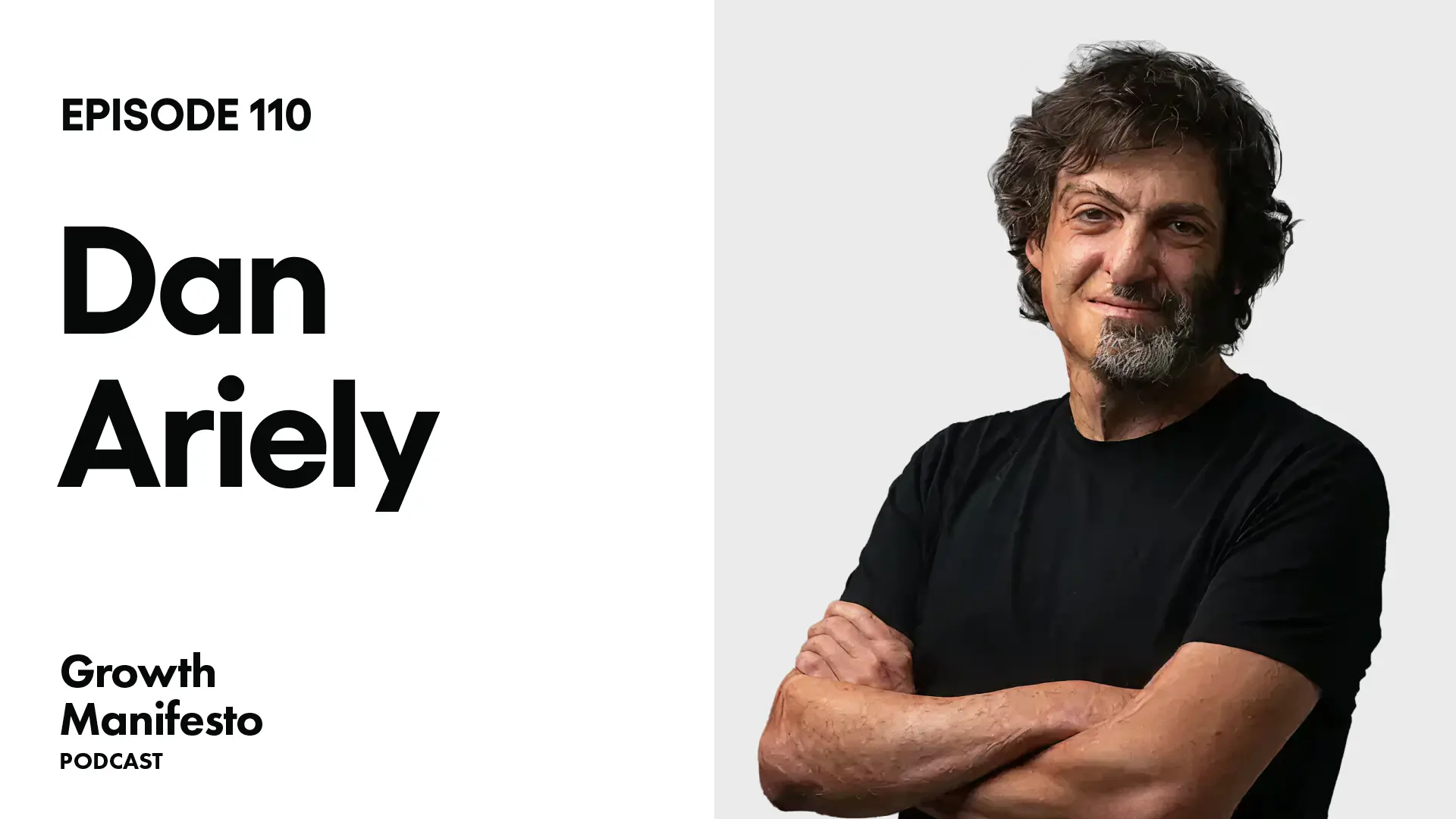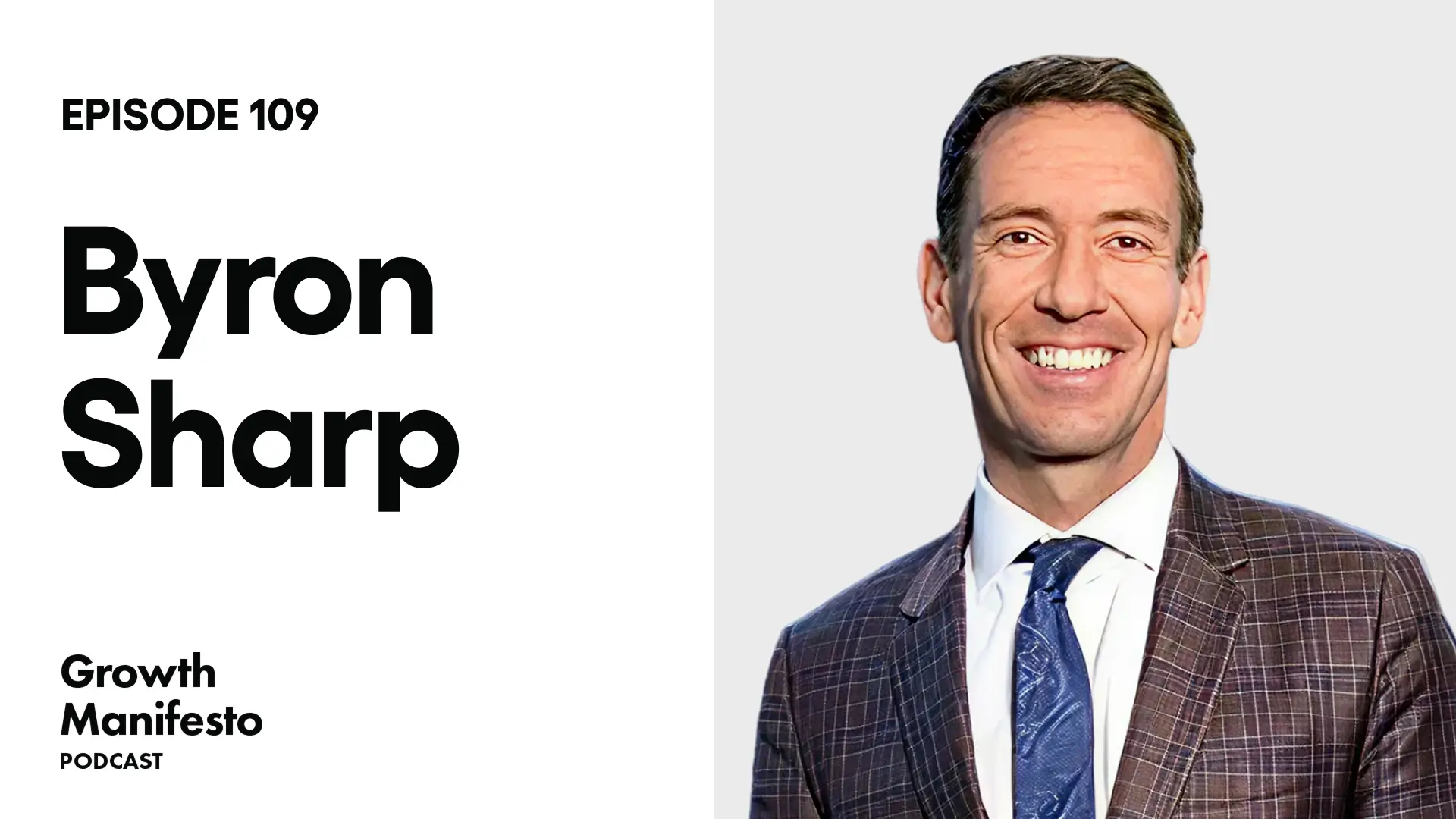How to use Movement Thinking to become a purpose-driven company
This episode is with Scott Goodson – CEO & Founder at Strawberry Frog and co-author of the book Activate Brand Purpose – How to Harness the Power of Movements to Transform Your Company. In this episode we talk about how to use Movement Thinking to become a purpose-driven company.
LINKS
- Activate Your Brand Purpose Book
- StrawberryFrog’s website
- Scott’s Goodson on LinkedIn
- Scott Goodson’s Twitter
—
You’re listening to The Growth Manifesto Podcast, a Zoom video series brought to you by Webprofits – a digital growth consultancy that helps global and national businesses attract, acquire, and retain customers through digital marketing.
Hosted by Alex Cleanthous.
- YouTube: https://www.youtube.com/c/GrowthManifestoPodcast
- Instagram: https://www.instagram.com/webprofits/
- LinkedIn: https://www.linkedin.com/company/web-profits/
- Facebook: https://www.facebook.com/Webprofits/
- Twitter: https://twitter.com/webprofits
- Agency: https://www.webprofits.io
SHOW NOTES
- 00:00:05 Scott Goodson’s introduction to the Growth Manifesto Podcast
- 00:00:43 What do you mean by movement thinking?
- 00:02:00 What is the perfect example of a purpose-driven company?
- 00:03:40 How did you choose in terms of brand purpose?
- 00:07:09 How do you connect the brand to a purpose?
- 00:12:40 Who in the company is vital to figuring out its brand purpose?
- 00:13:47 Is a token digital or physical?
- 00:17:30 What does activation really mean?
- 00:19:28 What are the steps involved to roll out effectively?
- 00:40:00 Is it correct that it doesn’t have to be (but can be) how you change the kind of message you deliver to the marketplace?
- 00:42:30 Is it correct that you don’t have to spend large amount to create a brand purpose?
- 00:45:20 For companies, is there a certain size that they should be before doing this?
- 00:50:05 What kind of organisations does StrawberryFrog help? And how do they get in touch with you?
TRANSCRIPT
Alex Cleanthous:
Today we’re talking with Scott Goodson, the CEO, and founder of StrawberryFrog. And co-author of the book Activate Brand Purpose , How to Harness a Power of Movements to Transform Your Company. For more than 25 years Scott’s book with companies like Google, Emirates, like Heineken, Coca-Cola, and Mercedes. And he invented the concept of movement thinking, which is what we’ll be talking about today. And just quickly before you get started, make sure to go ahead and hit that subscribe button. So you get the latest episodes as soon as they’re released now let’s get into it. Welcome, Scott.
Scott Goodson:
Thank you. Very nice to be here.
Alex Cleanthous:
Yeah. It’s fantastic to have you here. Well, let’s jump straight in. You talk about brand purpose and this concept that’s called movement thinking. What do you mean by these ideas?
Scott Goodson:
Well, it’s very simple. It’s using the principles of social movements in order to activate a purpose so that people like employees, as well as consumers really understand what you’re trying to do and want to be part of driving that change.
Alex Cleanthous:
So it’s connecting to something that’s already happening in the world. Is that correct? And then kind of –
Scott Goodson:
I mean, yeah you can have a movement that is about driving a form of positive change. It doesn’t always have to be that way. You could certainly have a movement of cultural engagement where people are participating in mass participation in a cultural idea that doesn’t necessarily have to drive positive change. But more often than not, it is about identifying something out there that is wrong, that you want to wHGrBHV ite, or some monster out there that you need to defeat.
Alex Cleanthous:
So it is connecting to something, right? And I think the best example of this, I think that everyone is Patagonia, right? That seems to be the poster child of what it means to be a purpose-driven company. Is that correct? Is that an example of a purpose-driven company?
Scott Goodson:
Absolutely.
Alex Cleanthous:
A company like Patagonia?
Scott Goodson:
Yeah. I think it’s a very good example. I think it’s through the lens of sustainability and taking a stand against any political or business decision that is jeopardizing the climate, that would be a perfect example. But I think there are a lot of other examples out there that are not necessarily connected to climate. There are ideas about all sorts of things. And in small ways and big ways, those ideas can drive positive change. For example, a few years ago we did a movement for Jim Beam which I know is very popular in Australia. It comes in cans, people drink it at the beach –.
Alex Cleanthous:
It comes in bottles too.
Scott Goodson:
And comes in bottles too. We did a movement against the patriarchy and for equality. And we had Milacunas as the first spokesperson for an American whiskey. That was a pretty big move for equality. And the net result of that was women felt the brand respected them and validated them. And as a result, they rewarded the company, and today a significant, I believe a majority of the consumers are under 45 and there’s at least 40% of them are women. So companies that do drive positive change are typically rewarded, especially these days with younger consumers.
Alex Cleanthous:
Okay. Let’s just go into that example quickly. How did they choose that in terms of their brand purpose? Because it seems like that would be on… It feels like that would be on the risky side because the Jim Beam, like the look and the feel is very masculine, across the past 20, 30 to 50 years, it has had quite a lot of masculine-
Scott Goodson:
Imagery.
Alex Cleanthous:
…advertising and so on, like imagery, the concept. So it feels like taking that stance could have been pretty risky for them. So what kind of considerations are happening at the time that there’s a purpose that is being selected?
Scott Goodson:
Well, in the case of Beam, the risky strategy would’ve to do nothing. I mean, because compared to Jack Daniels, which is more or less equivalent, it’s an American whiskey, corn based whiskey, one’s a bourbon and one’s an American whiskey in Tennessee. And one could argue, what’s the big difference and so forth. But from a macro perspective, they’re both American whiskeys. And Jim Beam was having their clock knocked by Jack Daniels.
Jack was 1299 a bottle for the same liquid. And Jim was like 799, and two free shot glasses at the bottom shelf at 7-Eleven. So they were in really bad shape. The average age of their customer was in their late 60s, all of them male. And so when you’re up against the wall, you’ve got to make some bold moves. And in today’s world, we’re living in a world of constant VUCA world volatility and change. You’re faced with a lot of issues all the time.
So I would say any move is a bold move. Doing nothing is a bold move. Doing nothing is probably the riskiest move. So in that particular case, they had a real business objective, which was to grow the business and increase household penetration, raise the price and to do that you had to completely rethink who the consumer was. And all the research we did here in the United States, in Germany, Australia, and the other core markets where Beam has been around for a long time showed that there was a lot of room for growth among women.
And that proved to be accurate. And you’re not going to attract women with a very traditional male patriarchal message. So nothing better than to take a page out of any social movement, giving women a platform and using that as a movement for Beam. And then hiring this woman, Mila Kunis and having her as the poster child of that. And the result was, as I said, the business turned around and today actually they’re doing better than Jack Daniels.
Alex Cleanthous:
Okay. So the right connection to the right movement can have a very positive impact on the company’s success, right?
Scott Goodson:
Right. Yeah.
Alex Cleanthous:
How does a company start to think about the cause, the movement, the purpose that it should be connected to? Because it seems like, yes, it’s definitely risky to not take action, but that’s the known entity, right? To take action in a specific area feels like it would be very scary for lots of executives, right? And so how do you start thinking about, so how do you connect the brand to some purpose?
Scott Goodson:
Well, I think so let’s just get some definitions down first if we can.
Alex Cleanthous:
Yes.
Scott Goodson:
So the purpose is what is the higher order idea that your organization is working towards that is beyond dollars and cents. It’s typically like what’s the soul of the organization. Why are you existing more than making money? And you’d be surprised at how many leaders out there actually are really passionate about climate sustainability, mental health, financial wellbeing, real issues that they come across through their employees, or their customers, or the communities within which they work. Those things are pretty normal.
And I think today leaders realize they’ve got to be aware of these issues and not everybody is able to activate it actually in a genuine way. But increasingly I would say leaders are pretty good in that space. If you are a leader and you’re trying to turn a purpose into a movement. Now, a purpose is that higher order strategy, the problem of the purpose is it can typically be either toothless. In other words, it feels so opaque. And just like, we want to drive some form of good for the world. I hear that more often than not-
Alex Cleanthous:
We’re positive people, we want to help. It’s like, yeah-
Scott Goodson:
We want to help.
Alex Cleanthous:
…I need a little bit more than that.
Scott Goodson:
We’re going to continue to make a million of these units a year, but we want to help. So when I started working with Purpose back in the ’90s, I lived in Sweden at the time. And as soon as we got out of the Nordics and we started to market outside in Eastern Europe and Asia, and even in Australia where we launched, for example, Ericson mobile phones I was working on at the time. And Ikea was another company. We realized that purpose was just way too theoretical. It was like taking a university course, a uni course, as they say in Australia is just so they –
Alex Cleanthous:
So they don’t say that elsewhere, it’s local. Is that just an Australian thing – uni?
Scott Goodson:
You don’t say uni like it’s university or not. In US, you say college –
Alex Cleanthous:
We shortened everything here.
Scott Goodson:
…different names. Yeah. Uni and I love how everyone in Australia says like your bathers or your son is –
Alex Cleanthous:
Your sonis-
Scott Goodson:
Sonis.
Alex Cleanthous:
…there they’re called swimmers, not bathers. Swimmers.
Scott Goodson:
Bathers.
Alex Cleanthous:
Well, or bathers. Yeah.
Scott Goodson:
Swimmers. Yeah. So the purpose is a bit theoretical. And movement is about activating that purpose. Like a social movement, any movement you know of women’s movement or the Black Lives Matter movement, whatever movement you can immediately go to that’s what a movement is. So how do you take a strategy, like a purpose, turn into an activation plan that people just genuinely and intuitively feel like they’re part of ? They get it, they’re emotionally connected, they’re passionate advocates. That’s what we’re doing with this movement thinking.
But getting back to what you asked me to answer your question, if you’re a leader you just really need to make sure you have a strong personal connection to the movement you’re participating in, or you’re leading. And a movement usually, as I said earlier involves a wrong that needs to be righted in the world. So it needs to be something that you’re super passionate about and that you have a personal affinity for. And also importantly, you can connect back to your organization in some way. It could be something you mildly agree with, but you just have to be careful that it’s not just something that you stick to the organization.
There was a company in the United States called Planters Peanuts. And recently they came out with a purpose, which was something about your energy, which made sense, because nuts are protein and give you energy to do great things. And then they did an ad where they talked about paying women the same as men and saying like, “If you don’t pay women the same as men, it’s nuts.” And it just feels like an opportunistic ad that has nothing to do with peanuts.
You know, it’d be like, I don’t know if you have like, in Australia it would be like paying women the same as men from Fosters Beer. How does that have anything to do with Foster’s Beer? So you have to have some connection to the organization, to what they do to what the leadership cares about and demonstrate because the consumers are sitting there waiting for an organization to say they’re going to do something and then do nothing, they just have an ad. So you’ve got to do something you’ve got to activate.
Alex Cleanthous:
It seems there’s a whole industry here. It’s called superannuation. It’s like a 401k, but there’s this whole thing in terms of the ethical, superannuation companies that only invest in ethical companies and so on, right? And it’s seen like some huge uptake in Australia through social media and just through connecting to what the audience actually are trying to change in the world. And they are voting basically with their superannuation dollars, right?
That they have to put somewhere, right? And that seems to be like a whole industry that’s been created through movements, right? It’s been so hard to differentiate between superannuation funds for quite a long time and now this whole thing in terms of this idea of ethical investing has opened up a whole area, right? But for most companies they can’t change their business model to create something that is about the movement.
And so they have to start to figure out, so what are the things which I can connect with, right? So let’s start by just quickly trying to pull it apart for a second so that the listeners can start to get the concept in terms of execution correct, right? So you’ve got the brand purpose, right? That’s part one. And that then leads to movement thinking, right?
Scott Goodson:
Yeah.
Alex Cleanthous:
So if I’m trying to figure out the brand purpose, who in the company needs to be brought into that because it feels like the bigger the company, the more stakeholders, the more opinions, the more diverse the possible purposes could be, right? So what’s a way companies can start thinking about trying to identify their brand purpose.
Scott Goodson:
Well, to answer the first part of that question, it has to be the very top, it has to be the CEO. If the CEO’s not bought in, if the CEO’s not part of it, it’s not going anywhere. And these days CEOs actually do want to be part of these conversations and sometimes other C-suite executives or board members want to be part of it as well. And you know, how do you go about finding it? Well, like I said, it has to be somewhat related to what you are doing.
So for example, here in the United States, there’s a very large financial institution and bank called SunTrust. And they hired BCG, which is a big consulting company to come up with their purpose. And I mean, there are a lot of companies out there that will do this for you. We do it as well, but honestly it’s not our expertise. Our expertise is in activating purpose. But in the case of SunTrust, they worked with BCG, they developed a purpose which was called lighting the way to financial wellbeing. That was their purpose.
And it’s a bit of a mouthful, hard to remember, keep in mind that a lot of tellers and banks are high school educated. So what does this mean to me? What does it mean to my family? Lighting the way to financial wellbeing. It’s a bit theoretical, perhaps. The good thing about it is, it’s about the consumer. It’s about the end user. It’s about lighting their well being. It’s about steps towards helping them achieve financial wellbeing.
So there’s a lot of good things in there, but the phrase is a bit heavy, hard to remember, difficult to share in a peer-to-peer world internally inside an organization. So we came up with a movement called on up and the onUp Movement was against financial stress and for financial confidence. And we set out to help Americans find financial confidence. And we said, “We are going to generate five million participants in this movement within five years.”
We ended up generating six and a half million in this movement in three years. So it was a huge success for a bank. I mean, can you imagine, a bank actually starting a social movement to drive some form of positive change in society? So it can actually happen. And that should give you a good example of what I mean by a purpose that can be a little theoretical that then is activated with a purpose. Sorry, with the movement.
Alex Cleanthous:
Yeah. With the movement. Okay. So just for clarity, the purpose is the idea, right? The purpose is the idea of what we stand for, right? And there might be a few ideas which a company could stand for, right? The movement side of things, the movement thinking of things is then the actions which-
…you are going to take to activate it, is that right?
Scott Goodson:
Yep. Correct.
Alex Cleanthous:
And it seems like, and this is just from what I’ve seen in the world, you know? So where a lot of companies fall down is they may come up with a brand purpose, but then the movement they don’t really invest in it like it’s a movement, they invest in it like it’s a little campaign on the side, right? And it seems like for a company to really be a purpose-driven company, it needs to be part of the company, right? And so can you talk about quickly, so what does activation actually mean and how integrated within the company should that activation actually be?
Scott Goodson:
It’s got to be throughout the organization. I mean, we’ve developed a tool called the purpose gap, which measures how well a purpose is activated in an organization from the very top, the moment the C-suite launches it to rapturous applause to three years later, how well is it being used at the bottom of the organization? And that’s really what it is all about. If you are launching a purpose and you’re activating in a way that engages people through actions and or communications, it should have a meaningful role in the organization 18 months later.
I guess the main way of thinking about the main framework of a movement is the difference between top-down leadership do this because I tell you to do it and cross-company leadership. Let’s do this because we all want to do it because it’s something that really matters to all of us, all who work in this company. And that’s really what it’s about. And if you are launching a purpose inside your organization and you’re measuring it over time and down through the organization and there is nothing happening, then you haven’t really activated it well.
Alex Cleanthous:
It starts internally, right? So the purpose always starts inside, right?
Scott Goodson:
Right. Yeah.
Alex Cleanthous:
And then it expands outside. This is something which you’re speaking about, in your book, right? And so what’s letting the role out of an activation, right? Cool. So we figure out the purpose, we identify the movement. So what are, not all the steps, but some of the key steps involved to roll this out effectively.
Scott Goodson:
Yeah. That’s a great question. I mean, in the book, Activate Brand Purpose, that’s really what we talk about. The basic premise of this is a brand or company can identify and crystallize a mass movement. That’s the basic idea and we’ve been doing this for 24 years. We’ve done it for Google, we’ve done it for Emirates, we’ve done it for Heineken in Holland, we’ve done it for LG in Korea, lots of different companies, Mahindraa, lots of different companies. We’ve been working with Afterpay, which is an Australian company or used to be, we just recently sold.
But once you have a cultural movement, you can do anything in the changing media environment. And a culture movement is, one in an idea on the rise inspires mass engagement by the culture. And the way you get going is first the strategy has to define the change you want to make. This includes what kind of behavior you want your customers to have in relationship with the company or what kind of social change you want to drive. And it has to be relevant to your business, as I said.
And then the second thing you need to do is you really have to understand your target. Why do they behave as they do? What’s important to them in the category that within your work, but also in their lives? What are the fundamental human truths that you need to identify? And then equally important for understanding your target, you have to understand the culture. What’s going on in the world? What’s happening in society that’s relevant to the purpose, to this idea that we’re trying to launch as a movement? And then understanding that people want to be part of something bigger than themselves.
And that’s what we’re designing for, right? That’s the framework we have. Of course, this strategy has to serve the benefit of the company, like with Jim Beam drive, ShareHarder or ultimately serve the benefit of the equity of the company in some way. But to begin the movement, start with your own people. So you start with the employees and then you also try to provoke a discussion. The biggest challenge you’re trying to overcome is complacency. And this requires you to turn deep human insights into sharp instigating. Something that galvanized people, if you’re not galvanizing people, then whatever you’re doing is not working. And companies are full of communication that employees know never to read or just align the walls of a lunchroom, no one ever cares about that stuff.
Then you want to build a community space where people can gather. Typically, that’s a digital place, but it can also be a physical place. Think of it as your movement hub, where ideas are shared, people come together, communities built. Then you want to develop your own must share content, storytelling, language. The more that you can create your own buzz words and phrases, the more they’re adopted by people. And then you want to have influencers and opinion formers involved so they can get great content out or at least help share your content with others.
You need to have the opportunity to launch some kind of an action. Something that people will disproportionately be receptive to that really lives up to the movement that you’re trying to bring to life. And once you’ve done that action or a couple of actions, then you can start amplifying that to a wider audience. And you can do that through social media, you can do that through paid advertising, you can do that through all sorts of different mechanisms, digital tools as well. And then social media becomes your cultural oxygen.
So social is very important both as a tool for consumers, but also for employees. Employees get their cues from social media of their colleagues. They don’t actually get it from internal communications anymore. So you’ve got to use social even to reach your employees. And then you’re nurturing that movement in real-time. So you’re able to watch where sparks start and engage with the conversation. So the fire keeps burning, does that make sense?
Alex Cleanthous:
Yeah, it does make sense. And thank you for that breakdown. That was a fantastic breakdown. What I was going to ask then is I could be wrong here. I probably am wrong, but it seems to be that this tends to be targeted more for consumer companies that have quite a large audience that can create a movement. So my first question – is that true? Or can smaller more niche organizations that don’t have such a big audience, can they still have a brand purpose and a movement? Or is that overkill because of the amount of actions that have to happen.
Because that outline seems like a lot of time and resources for helping the world, but also for upside potential to the company. So it would seem that the movements would have to be quite large to get that uptake. So is there a certain size organization, certain type of organization that this would be more suited to?
Scott Goodson:
So that observation is not accurate. So –
Alex Cleanthous:
Thank you for that. Because this is why I wanted to put stuff out. Because there’s going to be people thinking about it, including myself, right? And well, I do like B2B, is this the same? Or do I do that – is it the same?
Scott Goodson:
Now, B2B works for sure. I mean, I’ll give you an example. So we worked with a company called Rexo. It’s a Swedish pharmaceutical company that wants to enter the US market and they make something called, it’s like medically assisted treatment. It’s the medication that people that are addicted to opioids take to try to get off opioids. It’s a medicine you take, if you’ve never been on opioids, you won’t know what I’m talking about. But anyway, it’s a company that came to the US. They wanted to launch here and it was a B2B problem they had, they wanted to sell their product to doctors so they would prescribe the medication. And other buying groups for medical organizations.
And a major 80% of the market is run by one company called Subsalt. They make something called Suboxone, which is 80% of the market for that product. And these guys are coming in with better or better uses of the product. So I would use less of the medicine to solve the problem. So it was good because you don’t want to take too much of this medication anyway. So how do you come into a market you have this massive existing company that runs the market, 80% is this company. Plus you have a market that nobody really wants to engage in, so their position’s pretty secure.
So what we did was we said this opioid epidemic in America, nobody wants to talk about, which is true. And the reason they don’t want to talk about it is because it’s accidental opioid addiction. It’s doctor prescribed pharmaceutical driven, right? Now of course everyone’s aware of it, but five years ago, nobody talked about it. No articles existed in the magazines and newspapers, TV, no one talked about it. And yet, there was a jumbo jet of people falling out of the sky every month, people dying every month, 500, 700 people dying. Because of this accidental opioid addiction.
I’m not talking about choice, not people that choose to be heroin addicts. I’m talking about Johnny who plays cricket, falls down, breaks his leg, goes to the doctor and is given oxytocin. I don’t know what brands you have in Australia, but Percocet or something like that. And 25% of patients are immediately addicted to the medication, 25%. And of that 25%, 5% become heroin addicts. It’s just because they’re chemistry makes them immediately addicted, it’s very hard to get off of it.
So what we did was we created a movement called out the monster and the monster was accidental opioid addiction was about this whole issue of doctor prescribed opioid addiction. And we launched that movement in America. It completely blew the market upside down. It made this new company come into the market. Not only were they small, but it made them immediately the thought leader. They became the place of authority, they challenged the status quo of the sector, they started building momentum with the doctors and it was a classic case of how you established a leader in the category. And we did all that through movement driving positive change. So that was a B2B campaign. And the cost of that programme was as much as what it cost to do a traditional B2B marketing campaign. Wasn’t more expensive, it’s just a different framework for you.
Alex Cleanthous:
So thank you for that story because that helped to understand the concept a bit more. With this, the movement thinking approach is still talking to the consumer, it’s impacting the B2B side of things potentially, or the consumer side of things, right? It’s more just starting a conversation across the people that matter within the industry or the people which you are trying to help. And then –
Scott Goodson:
No. It doesn’t have to be the consumer. You can engage the consumer, but it doesn’t have to be the consumer. So I’ll give you another example. We did a movement for a company called Capgemini. It’s a big tech consulting company in Paris, they’re global. And years ago they acquired Stones Young tech consultancy. So they merged the two, so it was called CGEY for a period of time, and we did that merger. And Capgemini is this huge company. They do everything like outsourcing, they do technology consulting, they’re very highly regarded consulting company. And we said, well, we did some research. The leadership said to us, “We’ve done this new acquisition. We really want to get out there and tell the world what we do.”
And we went out and we spoke to buyers of Capgemini services IEC, C-suite leaders of big companies. And they said to us, we went in there, we put brochures on the table and we said, “Hey, you want to know what CapGemini does?” And they’re like, “We don’t have time. We don’t want to read brochures about what they do.” And then we said, “All right, that’s fair enough.” Which they don’t like, which CEO has time spent reading a brochure about a company that does tech consulting.
So then we said, “Okay, we have three photographs here.” One picture was of super sharp-looking young Harvard grads. In fact, it was a picture of Harvard. The next was a picture of guys who looked like lawyers, quite boring looking. And the third picture was a room of broken furniture. So we asked these people, which of these is Accenture? Which of these is McKinsey? And which of these pictures is cap gemini? And everybody pointed to the Accenture guys as the Harvard guys and everybody pointed to CapGemini as the broken furniture.
So we went back to the leadership. We had all this on video and we said, “Your issue isn’t that people don’t understand what you do. The issue is, you’re irrelevant. You’ve got to be relevant.” So we created a movement called defy the economy. And we took all their products and we put it into a packaging called the adaptive enterprise. So we said, if you buy the services of CapGemini, you become an adaptive enterprise. Our product is called the adaptive enterprise, your organization becomes adaptive. And that means you are part of the movement to defy the economy because the economy is a bit like a manic depression. It’s one day is up, the next day down. You can’t really predict what the economy’s going to do.
So don’t spend time trying to predict it because you can’t. Instead, you’ve got to be able to get out there and become an adaptive organization. And that was a pure B2B play, no consumers involved. I guess you could say it’s consumer language, consumer sentiment, consumer mentality. IBM for years said they always tried to bring the consumer mindset to their marketing, even though it was B2B, and they did a pretty good job. Most B2B companies are doing a horrible job, they try to be boring on purpose and buyers have considered purchasing equipment or services. They don’t want boring partners, they want partners that can make them feel excited. They want partners that make them feel like they understand where the world’s going. And more importantly can break through the wall of indifference.
Alex Cleanthous:
What I like about this conversation is all your examples are so different in terms of the movement, but they’re all the same kind of thinking. So it’s really stretching my mind in terms of, so what is a movement? And if you’re stretching my mind, I’m sure stretching the mind of the listeners too, that potentially aren’t across this kind of thinking, right? So it does seem that it should be linked in some way to what you do, right? Is that a fair saying, because that’s a fair statement. It should position you in some way that can make you stand out from the competition.
Scott Goodson:
What are you doing that nobody else is doing? That’s the question, right? Yeah.
Alex Cleanthous:
And then it should be bold enough that it can help to galvanize your staff plus the market, right? To get some conversations started.
Scott Goodson:
Yeah. Because it’s got to do two simple things. It has to increase the willingness for people to work for your company and it has got to increase the willingness of people to buy from your company. That’s all it’s doing.
Alex Cleanthous:
And what’s interesting is that, I think when people think of brand purpose and movement thinking, they think of Patagonia. They don’t think of the adaptive enterprise, right? And that adaptive enterprise that is still a movement right now, trying to find the movement that talks to your organization. That seems to be really quite challenging, right? Because you’ve got to pick something which you care about, then you have to pick something which is a real challenge. A challenge in the world, in the industry or whatever.
And then you have to create the frameworks internally and the message externally to communicate. And then you have to keep investing in it for a long enough time, is that right? In a nutshell, I’m still trying to just confirm that I get it, right? So if it’s wrong let me know.
Scott Goodson:
No. It’s right. I mean, it can evolve over time. For example, we did a purpose for Pampers, the diaper?
Alex Cleanthous:
Yep.
Scott Goodson:
Before we worked with them, basically they were the best engineered poop catcher. And we created a purpose called baby development. And baby development changed the game for Pampers because it gave them a really relevant idea that they could define their reason for being, but also create new types of products, new types of services that parents need. And that could also include communities of parents, tools that parents could use to become better parents.
And as a result, they transformed their business. They were behind the market leader here in the US called Huggies. They ended up usurping them, we ended up launching in China, we did Eastern Europe and Western Europe. So that simple idea of baby development it’s completely relevant to Pampers, of course. And during that programme, the movement, we launched a product that was two times thinner, that’s classic PNG two times thinner, two times drier. The new diaper was in feet of engineering, really quite extraordinary.
But what we did was we positioned it as a performance enhancing diaper, like you Australians are so good at Olympic swimming. So they wear that sleek glide enhancing textile. That’s like, what happens when you wear Pampers with Dry Max, this new product that we launched. And we connected it back to baby development, which was the fact that it’s thinner allows the baby to move freely. And that stimulates the brain, which is part of baby development. So everything we do is in the service of driving a better form of baby development.
And it just helped the company focus and grow globally, and that’s kind of it. It’s that and then activating it. For example with Pampers, I went to the leadership and I said you advertise to mothers after they’ve given birth because PNG as a company never spends a dollar advertising to noncustomers. So by virtue, a noncustomer is a prenatal mom. However, prenatal moms are true seekers. The minute parents find out they’re pregnant, they’re scouring the internet for anything they can get their hands on, which is when you want to be out there.
So we came up with this strategy called capture it conception, which was all about building tools and utilities out there that once you become pregnant, you can actually find Pampers. And we build a relationship because if you start building a relationship nine months out, they’re going to stick with you longer. And one of the biggest business problems that Pampers had at the time was that parents started off using Pampers because it’s insecure. And then after about a year, they go, “I’m actually pretty good at this, I don’t need Pampers anymore.” And they switched to a cheaper diaper.
You can use the cheaper diaper from the beginning, but Pampers has created this mindset that if you don’t buy Pampers, you’re a terrible parent. So nobody dares, until they build enough courage after a year and realize that Pampers actually is great, but there are other great ones outside too. So we were able through capturing conception to actually lengthen the time that parents use the product.
Alex Cleanthous:
So you mentioned before that the cost of something like this can be similar to any campaign that you launch, which means that it’s really the thinking, it’s the messaging, it’s how you talk about the brand now it’s how you integrate it, into what you’re already doing. It seems in hearing this conversation that this is a very expensive process, right? But from what I understand and correct me if I’m wrong, it doesn’t have to be, it can be of course, but it doesn’t have to be, it can just be how you change, how you talk about yourself and how you change the messages that you put out to the marketplace. Is that correct?
Scott Goodson:
Well, it’s not just how you put out in the marketplace. It’s your actions that are driving some form of positive change. It would be… like I was looking at something from Australia. There’s a guy I know whose name is Brent. He’s the CMO of a company in Australia, a big insurance company. And he came out with a programme called NRMA Insurance.
Alex Cleanthous:
Yeah. NRMA Insurance. Yep.
Scott Goodson:
Yeah. I think he’s the CMO of that company. And he did this movement and it was all about, it’s called the fire inside. There’s a fire inside all of us burning desire to help. And it was an amazing programme, a significant project, including a feature link documentary book to create a national movement in partnership with the Minderoo Foundation to mobilize Australia’s largest contingency of volunteers to prepare and protect Australia from future natural disasters. That’s a really great example of a movement. Like here’s an insurance company that is saying, “Look there fires coming every year, it’s not going away. We’re going to need a new way of thinking. We want to drive that conversation in society. And we’re going to bring lots of people together who otherwise wouldn’t be connected, but have a personal stake in seeing this succeed.”
And by doing so by virtue of being the ones crystallizing this movement, that organization, the NRMA Insurance group is going to be generating a lot of fans and a lot of positive feedback from their employees. They’re going to walk taller, their families are going to love them more. The CEO’s children are going to know and appreciate what their father or mother is doing. Because most children of CEOs don’t know what their parents do. All the positive things in life. That’s great.
Alex Cleanthous:
Yeah. So thank you for clarifying that, but on the investment side of things, right? It doesn’t have to be large. The intention and the action have to be completely aligned, right? And so you don’t need to spend significant amounts of money to have or to create the brand purpose and to maybe activate it. Is that right?
Scott Goodson:
Yeah. That’s correct. That’s right.
Alex Cleanthous:
And so what do you need that is critical to make this successful?
Scott Goodson:
I think you need an idea. That’s going to be relevant to your people and that they’re passionate about. And then you need to crystallize it in a way that feels it’s original and different. And I haven’t heard it before and then you need to activate it in a way that really makes a positive impression and people feel like it’s credible. And then you need to continue to do that. And it’s a bit like a tornado, what that is. You know what that is, a tornado yeah. If you think about traditional advertising, it’s very linear. You shoot a message out there, you pay money to run an ad. And when you stop paying for it just stops, awareness drops, no one remembers.
But a movement, it’s a bit like a tornado. It’s like a built in sustainability. If you push it every once in a while, it’s constantly churning. It’s constantly building energy up because the energy is coming from the people. It’s not a fake idea that you’re doing a really great creative ad and pushing it out there, which is in effect manipulation. This is what people already care about. You’re simply crystallizing energy that’s already in the world and you’re connecting it back to your organization in a credible way.
That’s what this is, you’re not making it up. It’s existing, the organization your people already care about. They just haven’t been able to understand because you haven’t articulated it very well. It’s funny when I talk to CEOs, I ask them, “This idea – is it so new?” And most of them are like, “Not really.” We actually did this a few years ago, but it wasn’t so clear. It wasn’t so well done. We didn’t ask people to be part of it. We didn’t ask them for their ideas. We didn’t ask them to help dry this or to help spread it among our people. So I think the tactics are really important, how you frame it, how you crystallize it, that’s really how you make a movement.
Alex Cleanthous:
Is there a certain size organization that is required before they start thinking of this kind of approach? Except for the ones that have the movement built into the product, the companies that have the product or service, and then they’re trying to create a movement. So for those types of companies, is there a certain size that they should be before they start even considering this?
Scott Goodson:
No, you can do it from scratch. You can be a startup and do it. You don’t have to be a company that is a billion dollar company. In fact, I would argue that the companies that are best at this are startups. I think that’s the, I mean the biggest opportunity today I think is to be solving world problems. You’re more likely to create a successful long term business if you’re not just creating a company that makes money, but you’re actually trying to solve real world problems. There’s some great examples out there, companies that do that.
Alex Cleanthous:
Okay. That’s great. And so it can be done from the startup stage. And if you’ve got your purpose baked into the personality of the company from the first day, that certainly will make it easier to attract people that think the same way and to attract clients that think the same way and care about the same issues as you, is that right? And that’s-
Scott Goodson:
Absolutely.
Alex Cleanthous:
…the core part of it.
Scott Goodson:
Yeah. Movement thinking, as we said in the book, Activate Brand Purpose movement thinking has changed behavior and minds for generations. And now it’s time for startups to apply this to the core of their business to drive tangible change. And entrepreneurs will be rewarded for it. The world’s full of problems to be solved. And each one of those represents an immense opportunity for startups. Why focus on an idea the world doesn’t need when there’s a great business to be had in solving real-world problems.
And there’s a company actually owned by an Australian guy who lives in the US called the HighBar. And he addressed the issue of plastic pollution and created a movement. And it’s basically a shampoo that comes as a bar, like a soap bar. But it’s high-quality shampoo, but comes in a brick and you use it in your hair. So there’s no plastic, zero plastic and clean ingredients, high performance. And they’re just killing it here in the US. And they started the company to do away with plastic. Because people are fed up with plastic in the oceans and eliminate single-use plastic.
So people, especially the younger generation these days are really passionate about it. There’s another company from Paris. Another startup that I was part of called Courbet, C-O-U-R-B-E-T. That is the world’s first man-made diamond jewel rebrand that uses repurposed gold. So the diamonds are made in labs, not blood diamonds. So they don’t destroy the earth. They don’t have slaves digging it up for nothing. This is lab-grown and it’s super hot right now among French millennials, youngers, who believe you can’t be beautiful unless you do good.
That’s the philosophy of Courbet. If you go to coubert.fr, you’ll see what I’m talking about. And that’s a really appealing idea to a lot of young people these days. Why should I buy a blood diamond when I can buy a diamond that, by the way, is a currency? Diamonds are currency, right? Like gold, like platinum, like titanium. So it’s a man-made diamond or a human-made diamond or a blood diamond, the value is the same. In fact, once you cut a lab diamond, you can’t even tell that it’s a lab diamond. So if you want to buy your fiance something amazing and save the world in the process, look at Courbet, that’s the main point of business, but try to drive some form of positive changes in the process.
Alex Cleanthous:
Yeah. Sure. And I think this has been such a fantastic conversation. I think it’s really understanding what the company stands for so what is a problem in the world that needs to be solved? And what is that company prepared to do to follow that movement through? Is that right?
Scott Goodson:
Yeah. Exactly.
Alex Cleanthous:
Thinking behind it. Now this is the work which you do at StrawberryFrog. So just for the listeners and the viewers to ask what kind of companies, so what kind of organizations does StrawberryFrog actually help? And how do they get in touch with you?
Scott Goodson:
First of all, if you want to find out the answer to those questions, you can email [email protected]. She interacts with people that want to find out whether we can help them [email protected]. I would say, my personal objective is to make the biggest impact possible. So large organizations are great, but I also like working with startups that are well funded and want to do something genuinely positive before the cataclysm comes, something positive. That would be great, with a really cool product that excites us would be great.
So I would say both of those types of firms. And even companies if you’re a leader and you’re listening to this and you’re like, “Well we make widgets and God we’re really boring.” Well, no, you might have something really valuable to say or do in this world. I mean, there’s a lot of big issues we’re dealing with right now, right? There’s mental health, there’s financial issues, there’s issues that have to do with the community, the local community as well as the global community, there’s issues about education and there’s issues about toxic food. I mean, there’s so many issues out there, honestly. That regardless of what you do, there’s ways that you can drive some sort of positive change as well.
Alex Cleanthous:
That’s great. And just for the listeners, so for the people who like this conversation, you’ve got to check out his book, it’s called Activate Brand Purpose. It’s not too long. So it’s quick and punchy and we’ll just explain exactly what you need to do. And it’s such a good idea for all companies to consider, because if you can link the success of your company to actually helping the world, what better initiative is that. And so look, Scott, thank you so much for coming on the podcast and talking through the ideas of the brand purpose, the movement thinking ideas. These are extremely contemporary right now. And there’s a lot of organizations that are thinking about this, but they’re not quite sure where to start. And so thank you so much for explaining this.
Scott Goodson:
Absolutely. It’s a pleasure to be here. I’m passionate about this. All of us need to try to do something and make these problems at least emphatic as they are. And I mean, there’s so many issues now with quality and inclusion and issues around sustainability. I mean, there’s just so many issues out there. There are issues coming out of COVID, people have I’ve been through such difficult times, communities, employees. So for me, it’s a personal commitment, something that I’m really passionate about. I’ve been doing this for 30 years and by the way, the book is great. But if you really want a great experience, check it out on Audible. Because the Audible, we have this guy who’s read it. And he does all the New Yorker readings if you’ve ever listened to New Yorker Magazine. So it just sounds so amazing. Like the book is well written, but when he reads it, it’s like 10 times more… So try that one too.
Alex Cleanthous:
Well, I’ll definitely get it after this. I mean, I bought the book and I normally like Audible, but yeah I would check out the book as well. Because now I’m really interested. Scott, thank you so much for coming on the podcast and we’ll talk soon.
Scott Goodson:
Pleasure. Have a great day. Thank you for inviting me on, love it.
Alex Cleanthous:
Fantastic. Thanks for listening to the Growth Manifesto Podcast. If you enjoy the episode, please give us a five star rating on iTunes. For more episodes, please visit growthmanifesto.com/podcast. And if you need help driving growth for your company, please get in touch with us @webprofits.io
Now that you’re here…
Why not take a few minutes to see how Webprofits can help you achieve your growth aspirations?
We helped one company grow from $25M to $190M revenue in 4 years, and we work with challenger brands that want to make a serious impact in their industry and have the resources (and the will) to make it happen.
If you want a growth strategy that leads the way in your industry, find out how Webprofits can help you transform your digital marketing.
See what we can do











